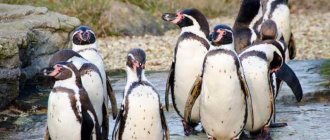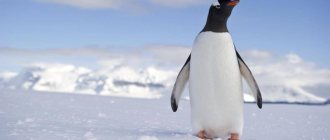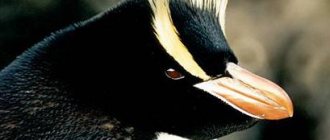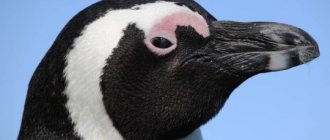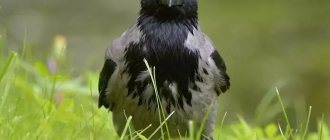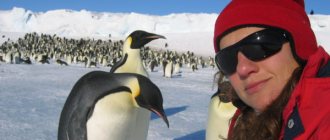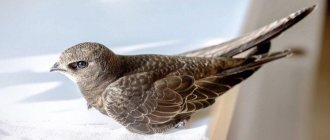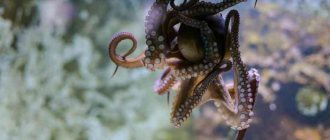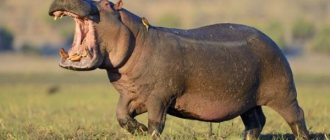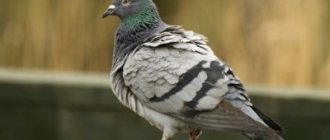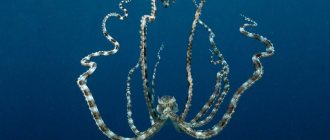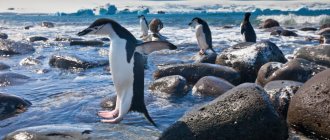In the Falkland Islands, a remote chain of islands in the South Atlantic Ocean, there are more penguins than people. Paul Grace Photography Somersham/Getty Images
Penguins are cold-adapted flightless birds known for living in the cold tundra of Antarctica. But of the world's 18 penguin species, only two live on the southernmost continent. Penguins live on all continents of the Southern Hemisphere, from Australia to Africa. They can be found along the coast of South America, as well as on tiny rocky islands far out to sea. The northernmost species, the Galapagos penguin, lives near the equator in the Galapagos Islands. The Adelie penguin colony, nesting near Cape Royds in Antarctica, is the southernmost species.
From New Zealand to South Georgia Island, here are 10 places where penguins live in the wild.
Rescue in Antarctica
This year, +20 degrees Celsius was recorded in Antarctica. Warming is dangerous, first of all, for emperor penguins, since they breed exclusively on ice shelves, and if the ice melts, the species may disappear. Those who breed on land are safe. Birds are also threatened by oil pollution. When oil products wet the plumage, hypothermia and death occur. The plumage can be washed from oil, but poisoning with oil products leads to disruption of the liver, as a result of which even washed birds die from liver dysfunction. But in Antarctica there are no special communication routes or tanker routes.
Penguins can get caught in abandoned nets in Antarctica and ingest plastic garbage, of which there is little in Antarctica - it is prohibited here to throw away any garbage from ships, except organic.
For penguins that do not live in Antarctica, there is another danger - the introduction of mammals, for example, mice and rats - they eat their offspring. This is a serious problem that New Zealanders and Australians are actively struggling with. But Antarctica is protected from this, since mammalian predators will not survive the winter.
Roughly speaking, the penguins living in Antarctica are relatively safe, except for the emperor penguins, which may become extinct.
Dmitry Kuznetsov, Phenological Network of the Russian Geographical Society
Interesting Facts
Diving penguins
- Male emperor penguins incubate eggs for 65-70 days. Females spend this time in the ocean. Then the parents take turns feeding the chick.
- The most determined one jumps into the water first. The rest, obeying the instinct of group behavior, dive after him.
- The parents regurgitate the semi-digested food into the chicks' mouths.
- In England and the USA, Antarctic penguins are called "macaroni". In the 19th century, this was what fashionistas were called.
- Chinstrap penguins build small nests from mud and small stones.
- Magnificent penguins spend very little time in the water. They prefer dry land.
- A male spectacled penguin expresses affection by gently stroking a female's head.
- The cries of penguins keep New Zealanders awake.
- Penguins are only clumsy on land. Underwater they turn out to be very dexterous and graceful.
Narwhals live only in the north
Narwhals are also sometimes called unicorns because of their long spiral horn protruding from their forehead. This Arctic animal is often spotted in Arctic waters. Narwhals live here all year round. They spend the summer in ice-free coastal waters, and in the winter they move further to look for food under the moving ice. They use cracks and fissures to breathe.
Organizer for small items in 10 minutes: I make it from jute rope
Dresses, stockings, fans with pearls: the Hermitage donated a collection to the Historical Museum
Traveling around Russia and saving: how to get some money back for your trip
penguins-56097_1920.jpg
Photo from pixabay.com
Why don't penguins fly?
This pressing issue was resolved by scientists from the USA and Canada. During the research, they found that penguins lost the ability to fly during the process of evolution. To improve their diving ability, birds had to reduce the size of their wings or increase their body size. Both ultimately made penguin flight impossible.
Despite this, penguins are excellent swimmers. Unlike flying birds, they do not have hollow bones. The entire body of penguins, especially the wings, which resemble fins, are adapted for fast and maneuverable swimming. Working with their wings like propellers, these heavy birds are capable of reaching speeds of up to 50 km/h in the water and literally “shooting” out of the water onto the shore. In addition, some species of penguins can also dive to depths of up to 500 meters.
The largest land animal is the midge
When it comes to Arctic predators, there is one beast that rules them all: the polar bear. These giant animals are distributed throughout the region as far as James Bay, which is at the same latitude as London.
Children who spend more than an hour a day on the phone will have social problems
She was called the Russian Monroe: how the life of the beautiful actress Natalia Lapina turned out
A little epoxy, a couple of boards - and the illuminated table is ready: simple instructions
Ice is important to polar bears, who use it as a hunting platform to catch seals. As soon as they rise in search of air, the bears grab them and pull them onto land. “Simply put, polar bears evolved to be able to feed themselves in the Arctic,” says Ian Stirling, a scientist and professor at the University of Alberta.
Meanwhile, there are no land-based predators in the south, says Andrew Desrocher, an ecologist at the University of Alberta. As the coldest, driest and windiest place on earth, Antarctica is basically a vast, lifeless desert. The largest land animal is the wingless mosquito Belgica antarctica, the adults of which live for about a week.
Therefore, penguins, which are numerous on Antarctic coasts, especially on the Antarctic Peninsula and Ross Sea, are considered coastal animals and not land dwellers. So, despite what you may see in cartoons and popular media, there are no penguins at the South Pole.
Nutrition
It is interesting not only where penguins live - in the Arctic or Antarctic, and what these animals eat. Naturally, their diet consists of inhabitants of the deep sea. First of all, this is fish, almost any that is found in the habitat (sardines, Antarctic silverfish, anchovies).
Knowing the answer to the question: “Where do penguins live - in the Arctic or Antarctic?”, and what they eat, we can also assume that their diet includes crustaceans. But these species have to feed more often, but spend less energy searching, diving and eating small crustaceans.
Do birds live in captivity?
If you are interested in zoos, then you know: penguins exist and breed there very well. An interesting fact has been established.
When scientists asked how long penguins live, it turned out that captivity contributes to the length of their life. That is, in nature, birds die faster. Most likely, this is due to difficult living conditions, difficulties in obtaining food, and many enemies in natural areas. Special nurseries are now being created, the purpose of which is to recreate the numbers of those populations that reach a critical level due to human progress. If birds are protected from natural predators, the survival rate of the offspring increases significantly. Thus, scientists have calculated that only half of the hatched chicks survive to one year. If you take into account the loss of eggs, then twenty percent. However, the species live and reproduce well. Apparently, the main task of man is not to interfere with penguins decorating the planet with their beautiful diversity.
penguins-429128_1920.jpg
Photo from pixabay.com
Do penguins have enemies?
The main advantage of penguins is that these birds mainly nest in isolated areas. For this reason, adult individuals have virtually no natural enemies on land. But chicks left without parental supervision on the shore have a hard time. They are easy prey for birds of prey. Some species of seagulls even steal penguin eggs. The vulnerability zone of these birds is the sea. In the water, they are hunted by leopard seals, seals, lions, killer whales and sharks.
izobrazhenie_siggy_nowak_s_sayta_pixabay-emperor-penguins-429127_1920.jpg
Photo from pixabay.com
Who are penguins?
Penguins (lat. Spheniscidae) belong to the family of flightless seabirds, whose representatives swim and dive well. These animals are the only modern ones in the order of penguins (Sphenisciformes). There are 18 living species of penguins in the family. The largest of them is considered to be the emperor penguin: its height can reach 120 cm and its weight can be more than 40 kg. The smallest representative of the species is the little (or blue) penguin. The average height of this bird is 33 cm, and its weight does not exceed 2.5 kg. This significant difference is explained by the so-called Bergman rule. According to it, animals that live in cold regions have larger body sizes than those that inhabit “warm” latitudes. This contributes to a more rational ratio of the volume and surface of the animal’s body, which, in turn, reduces heat loss.
Types of penguins
There are now 18 species of these flightless birds on Earth, which share the coasts with seals, elephant seals and other Antarctic animals. Often different penguins become neighbors in the same territory. Let's get acquainted with the most numerous species.
Emperor penguin
This is the largest penguin of all. Males on average have a body up to 130 cm long and weigh up to 45 kg. Emperor penguins live near the coast of Antarctica, and lay their eggs on the mainland itself. This species of bird can be recognized by the yellow-orange spots on its neck.
King Penguin
It is found on the islands of the Southern Hemisphere: Kerguelen, South Georgia, South Sandwich and others. King penguins are not as large as emperor penguins, but they have a brighter color: red-orange spots on the head and chest.
Such penguins are caring parents; in order to protect their offspring, they look for icy slopes or other hard surfaces for nests. At birth, king penguin chicks look nothing like adult birds - they have a fluffy brown coat that fades over time.
Chinstrap penguin
These birds are also difficult to confuse with someone else. Their distinctive feature is a black stripe on the chin from one ear to the other and a black beak. These penguins are also called excellent climbers because they climb icy slopes using their beaks as a pick. Here the birds build their nests, fiercely defending them from predators.
Adelie Penguin
These birds live on the coast of Antarctica and on the islands closest to the mainland. Adelie penguins are small, with a white ring around their eyes, and their white belly and chest, black back and head create a very serious appearance. But in fact, such birds are very trusting and curious.
When hunting, Adeles try to stay together, waiting for their relatives at the edge of the slope so that they can jump into the water together.
Gentoo penguin
The largest after the imperial and royal ones. It is easily distinguished by the white spots in the form of triangles above the eyes and the legs and beak of a bright orange-red color.
You can meet the Gentoo penguin near the Kerguelen and South Georgia archipelago, as well as the Falkland Islands. Gentoo penguins are the fastest and fastest swimmers compared to others.
Magellanic penguin
Named after the famous navigator Ferdinand Magellan, who discovered the habitats of these birds.
Magellanic penguins are distinguished by their black stripes on their white necks. They make nests not on hard surfaces or ice, but in burrows that they dig themselves.
These penguins live off the coast of South America, on the Falkland Islands and Juan Fernandez.
Galapagos penguin
It is named after its habitat - the Galapagos Islands. These penguins live only here, near the equator, where temperatures can reach 28 degrees Celsius. They have an unusual spotted color with a white stripe from the throat to the beak.
